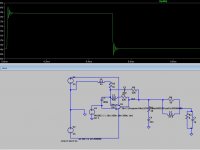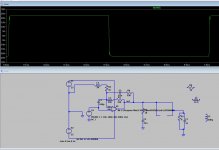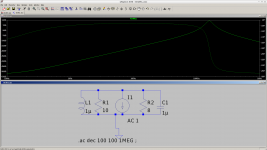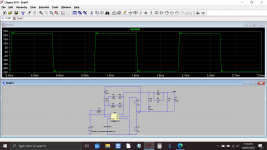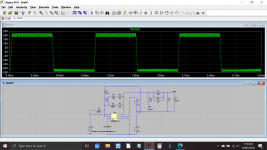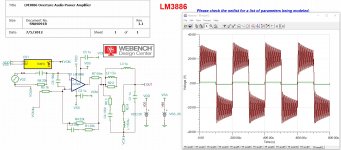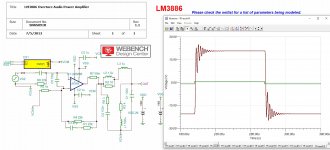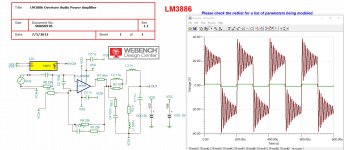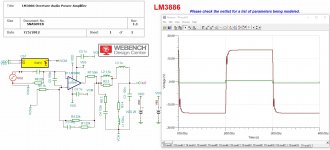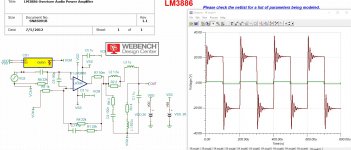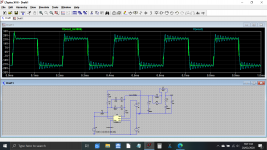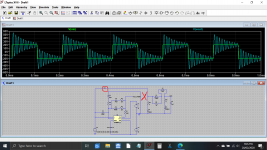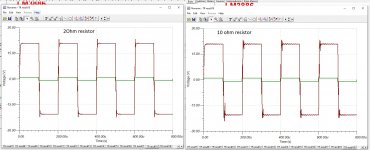Hello! I am having some troubles in simulating a very common (maybe the most common) configuration for the lm3886. I didn't find any discussion about this specific issue. I hope I am not reproposing an old topic and that someone will help me 
Basically, I am trying to determine the effect of a thiele network when a capacitive load is connected (2uF || 8ohm). I also tried to include a series inductance on the load, but it doesn't change the result.
The simulation results are very unexpected, and i suspect (I hope) there is some kind of bug. I downloaded the simulation model from the TI site.
As you can see in the attached pictures (I hope they are readable ), on a transient response simulation, the presence of the thiele network gives place to a terrible ringing. And as far as I know theory tells the opposite thing.
The strange thing is that i also tried to replace the lm3886 with a LT opamp that is not unity gain stable, with the same result. It was a low power amplifier, therefore i resized the load accordingly.
Is there any flaw in my simulation?
The parasitic inductances included in the feedback network have no effect on the simulation (i tried to remove them).
Maybe someone compared the square wave transient response with and without thiele network with an oscilloscope on a real circuit?
Thank you in advance for any reply
Basically, I am trying to determine the effect of a thiele network when a capacitive load is connected (2uF || 8ohm). I also tried to include a series inductance on the load, but it doesn't change the result.
The simulation results are very unexpected, and i suspect (I hope) there is some kind of bug. I downloaded the simulation model from the TI site.
As you can see in the attached pictures (I hope they are readable ), on a transient response simulation, the presence of the thiele network gives place to a terrible ringing. And as far as I know theory tells the opposite thing.
The strange thing is that i also tried to replace the lm3886 with a LT opamp that is not unity gain stable, with the same result. It was a low power amplifier, therefore i resized the load accordingly.
Is there any flaw in my simulation?
The parasitic inductances included in the feedback network have no effect on the simulation (i tried to remove them).
Maybe someone compared the square wave transient response with and without thiele network with an oscilloscope on a real circuit?
Thank you in advance for any reply
Attachments
Thank you all!
Hjelm, your hypotesis seems very convincing. On an ac simulation i have a peak in the voltage output that goes with the inverse square root of LC, so it must be that, in my sim.
Mooly, according to your results, the thiele network helps like i should. I must have done something wrong when including the device's model.
I'll try to read more about the topic, and also to install tina-ti, that might be a better option than ltspice for a TI device.
Thank you again and best regards!
Hjelm, your hypotesis seems very convincing. On an ac simulation i have a peak in the voltage output that goes with the inverse square root of LC, so it must be that, in my sim.
Mooly, according to your results, the thiele network helps like i should. I must have done something wrong when including the device's model.
I'll try to read more about the topic, and also to install tina-ti, that might be a better option than ltspice for a TI device.
Thank you again and best regards!
Update:
It is very interesting how it works: I used tina-ti and the results are a bit different, but not completely. With the same schematic as the one I initialy posted, i still have instability, but if the parallel resistor in the thiele network is of a lower value, everything works perfectly. maybe an excessively resistive resistor does not provide a sufficient damping. the best results are obtained with an inductance of about 1.2 to 1.5uH and a resistance of 2 to 3ohms. I'll soon take some clear pictures and post them.
Also the capacitor between the inputs plays some role, giving slightly better performance with a value around 120 to 150pF. I will trust the TI datasheet which specifies that the capacitor in that position is needed for preventing ringing during clipping events. I hope that there is a bit of tolerance for that function, and that real circuits will be forgiving if i use that value instead of the 220pF listed.
A wonderful thing is, that a ready made simulation setup for the lm3886 is available on tina-ti between the examples. I modified the schematic of that simulation setup in order to obtain my results.
It is very interesting how it works: I used tina-ti and the results are a bit different, but not completely. With the same schematic as the one I initialy posted, i still have instability, but if the parallel resistor in the thiele network is of a lower value, everything works perfectly. maybe an excessively resistive resistor does not provide a sufficient damping. the best results are obtained with an inductance of about 1.2 to 1.5uH and a resistance of 2 to 3ohms. I'll soon take some clear pictures and post them.
Also the capacitor between the inputs plays some role, giving slightly better performance with a value around 120 to 150pF. I will trust the TI datasheet which specifies that the capacitor in that position is needed for preventing ringing during clipping events. I hope that there is a bit of tolerance for that function, and that real circuits will be forgiving if i use that value instead of the 220pF listed.
A wonderful thing is, that a ready made simulation setup for the lm3886 is available on tina-ti between the examples. I modified the schematic of that simulation setup in order to obtain my results.
Here are the simulation results:
Actually I said something a bit wrong in the previous post, thiele network always helps a bit, according to Tina-ti simulations, but still, 10 ohms look like they are too much. Very good results are obtained with 2 ohms. I always used 1,5uH of parallel inductance
I applied a capacitive load of 1uF and i assumed 1uH of speaker wires inductance.
I also included the simulations results obtained with a more "gentle" capacitive load.
Cheers
Actually I said something a bit wrong in the previous post, thiele network always helps a bit, according to Tina-ti simulations, but still, 10 ohms look like they are too much. Very good results are obtained with 2 ohms. I always used 1,5uH of parallel inductance
I applied a capacitive load of 1uF and i assumed 1uH of speaker wires inductance.
I also included the simulations results obtained with a more "gentle" capacitive load.
Cheers
Attachments
Interesting 
I think you will find that the ringing is caused not by the LM3886 but simply the network attached. You can show that by simply connecting the network to the input voltage source and setting that source to -/+20 volts peak amplitude.
If you look at the LM3886 output directly then it should be quite well behaved (no ringing).
I think you will find that the ringing is caused not by the LM3886 but simply the network attached. You can show that by simply connecting the network to the input voltage source and setting that source to -/+20 volts peak amplitude.
If you look at the LM3886 output directly then it should be quite well behaved (no ringing).
- Status
- This old topic is closed. If you want to reopen this topic, contact a moderator using the "Report Post" button.
- Home
- Amplifiers
- Chip Amps
- lm3886: ltspice simulations issues
